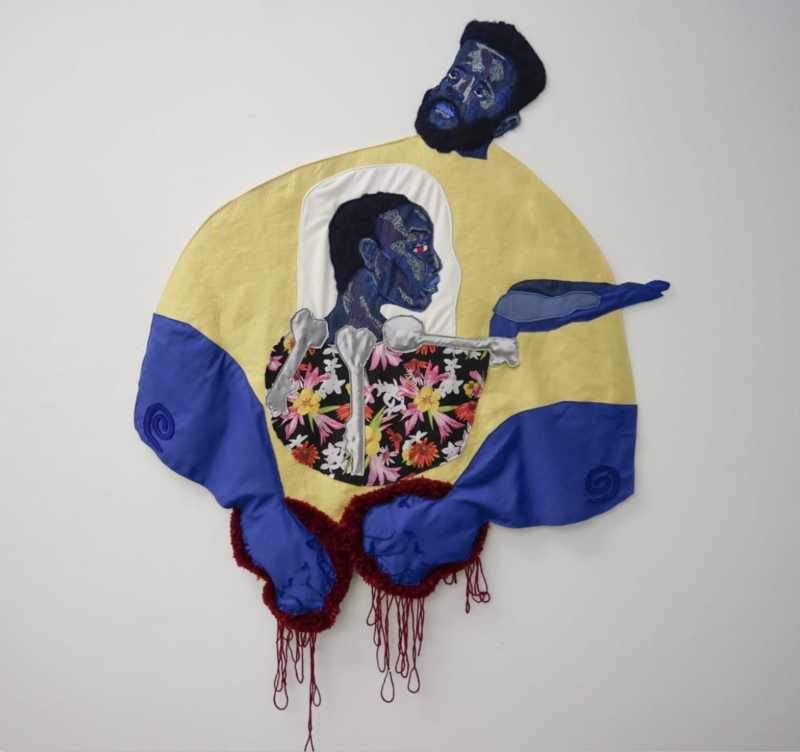Jasmine Best, 'Screend In', 102 x 240 x 144 in
"I hope my work sparks conversations. Making work is the easiest way I can communicate with others."
Artwork Archive's Featured Artist Jasmine Best is a true Southern Artist, gathering narratives from her Carolinian family and childhood. She uses her personal memories and manipulations of her memories to create dialogues about the Black femme identity in the South and in predominantly white spaces.
Jasmine delves into the essence of memories, viewing them as the cornerstone of identity—malleable yet potent, capable of shaping our perceptions and interactions. Through her work, she revisits pivotal moments from her past, offering both a better understanding of her own background as a Black Carolinian woman and inviting viewers to find relatable connections from their own experiences.
"I am creating a platform for discussion of Black femininity in predominantly white spaces. I'm also creating a vehicle where my audience can make connections of representation (or lack thereof) in their own youth and how that affected them," the artist explains. For Jasmine, medium specificity is the best way for her to materialize memories. "Specific fabrics, prints, animation styles, objects, mark making, and compositions can all bring to mind a certain time, place, emotion, or person," she writes in her artist statement. "I shift between digital and tangible mediums to best articulate my memories because I grew up during the transition from analog to digital."
Through her artwork, Jasmine Best not only crafts evocative visuals but also fosters a deeper understanding of personal histories and collective narratives. Her art transcends boundaries, serving as a poignant reminder of the power of remembrance and the enduring, generational legacy of the Southern experience.
Artwork Archive had the chance to chat with Jasmine Best about the meaning behind her work, what success as an artist means to her, and how Artwork Archive makes her art career more manageable!
You can see more of her work on Discovery and learn more about her art practice below:

Jasmine Best, 'Afrominimalism', 22 x 82 x 44 in
Do you have a favorite or most satisfying part of your process? If so, can you share a bit about it?
I view my artistic practice as a cycle that starts with research followed by sketching, drawing, and then constructing before cycling back to research.
I really love the drawing phase of my practice because I view mark-making as a form of problem-solving.
Your work often features maternal figures. Could you share more about the significance of these figures in representing Black southern women through generations?
I identify as a descendant of those who chose to stay in the southern United States, versus those who participated in the Great Migration. Therefore, it's important to me to acknowledge those women who came before me, who had ties to this land and passed down their drive to create.
These women were artists who could only curate within their own homes. When I work in my studio, I feel closest to these women.
You mention that medium specificity is the best way for you to materialize memories. Where do you source your specific fabrics, prints, and objects that contribute to this part of your creative process?
I find a lot of fabric at thrift stores or used art supply shops. Lately, I’ve been going to fabric outlets that are only open once a month or so.
Recently, I’ve also started doing more woodworking, which means I have to visit lumber yards—they don’t hover the way people at hardware stores do when you shop.
Also, when people know you work with fabric and textiles, they tend to donate random stuff to you—projects they never finished, things they picked up at estate sales, and materials they've cleaned out of closets. I even had someone drop off raw wool to me after just one conversation—they then passed away a few weeks later.

Jasmine Best, 'The Devil Taught Her How to Use Em', 59 x 44 in
What impact do you hope your work will have on those who view it?
I hope my work sparks conversations.
Making work is the easiest way I can communicate with others. I don’t always feel listened to and I’m naturally a quiet person. So, I hope my work makes people want to listen to what I have to say and know I am someone who considers their words thoughtfully.
What does success as an artist mean to you?
Success as an artist is living a life you created versus what others think is best for you.
It means setting your own hours and doing work you are passionate about. Your work should replenish you and also provide something to others.
I’m really big into setting goals and breaking them down to achieve them bit by bit. I don’t think there is one set achievement that I will acknowledge as success for myself. Because of that, I will always be working toward new goals and improving. But, I think being able to do so with complete confidence in my ability will lead me to many successes in the future.
Do you have a favorite (or current favorite) piece of your own artwork, and if so, what makes it special to you?
I think my favorite work is always the one that isn’t finished yet because I am most excited about what I am currently working on.
Among my finished work, I'm particularly a fan of my piece Don't You Know Your Skin?. In this piece, I tried some new techniques on a material level with liquid latex. Additionally, this work marked a shift in my research, focusing on Black folklore.

Jasmine Best, 'Don't You Know Your Skin'
Why did you decide to use Artwork Archive to inventory your artwork and manage your art career?
A few years ago, I was a recipient of the Artwork Archive Art Business Accelerator Grant and started using the inventory management system.
It proved way more efficient than the self-made document I was using before. More importantly, it could store more information and help prevent me from double booking artwork for exhibitions.
How do you use Artwork Archive on a daily basis?
On a regular basis, I use it to make Catalog and Portfolio Pages. I also use it to check artwork information, such as dimensions and medium, to send to curators and include in applications.
Artwork Archive Tip:
Leverage Artwork Archive's tools to elevate your applications for artist opportunities and present yourself more professionally to curators and clients. Maintaining detailed records of your artwork, including high-quality images, dimensions, mediums, and provenance not only streamlines the application process but also guarantees you can quickly respond to curator inquiries with accurate and organized information.
What advice would you give an artist who’s just starting out in their professional career?
There is no right or wrong way to be an artist.
Do not let preconceived notions of what you think you “should” be doing as an artist stop you from making decisions that are relevant only to you.
Additionally, always consider how you plan to ship and store your work—not enough people talk about that.

Jasmine Best, 'Portrait of Lily Roberts', 30.5 x 30 in
Jasmine Best uses Artwork Archive to organize her artwork, generate professional reports to send to curators, keep track of important information, and a whole lot more.
You can make an online portfolio, catalog your artwork, and generate reports like inventory reports, tear sheets, and invoices in seconds with Artwork Archive. Take a look at Artwork Archive's free trial and start growing your art business.


.png)





